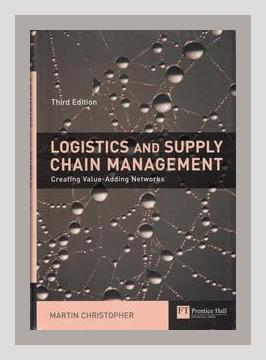Operations and Supply Chain ManagementService OperationsInventory Management
Introduction
“Logistics and Supply Chain Management: Creating Value-Adding Networks” by Martin Christopher, published in 2016, provides comprehensive insights and advanced principles in inventory management and service operations to enhance logistics and supply chain processes. The book underscores the shift from traditional logistics to a more integrated supply chain management approach that emphasizes creating value through network optimization. This summary highlights key points and examples from the book, with actionable advice for implementing the concepts.
Key Concepts and Principles
1. The Evolution of Supply Chain Management
Major Points:
– Evolution from logistics to integrated supply chain management.
– Role of technology and globalization in transforming supply chains.
Actionable Advice:
– Example: Shift from a siloed logistics approach to a holistic supply chain strategy.
– Action: Integrate cross-functional teams that include procurement, logistics, and customer service to ensure all aspects of the supply chain are aligned towards common goals.
2. Understanding Supply Chain Dynamics
Major Points:
– Importance of managing supply chain dynamics to cope with complexities.
– Real-time information sharing as a critical element.
Actionable Advice:
– Example: Analyze supply chain as an interconnected system rather than isolated components.
– Action: Implement real-time data sharing systems to foster transparency and quick decision-making across all supply chain partners.
3. Designing the Supply Chain Network
Major Points:
– Strategic network design to optimize logistics performance and cost.
– The balance between centralization and decentralization in network design.
Actionable Advice:
– Example: Using network design tools to visualize and optimize the supply chain network.
– Action: Create a dynamic network model utilizing software tools to predict the impact of changes in the supply chain, enabling proactive adjustments.
4. Inventory Management Essentials
Major Points:
– Importance of balancing inventory investment with service level goals.
– Lean inventory principles for minimizing waste.
Actionable Advice:
– Example: Deploying Just-In-Time (JIT) inventory systems.
– Action: Develop close relationships with suppliers to enable more frequent, smaller deliveries, reducing the need for large inventories.
5. Strategic Sourcing and Procurement
Major Points:
– Strategic importance of sourcing to supply chain efficiency.
– Role of supplier relationships in driving performance.
Actionable Advice:
– Example: Implementing supplier performance metrics.
– Action: Develop a supplier scorecard system to evaluate and select suppliers based on quality, reliability, and cost-effectiveness.
6. Managing Demand and Matching Supply
Major Points:
– Techniques for demand forecasting and planning.
– Synchronization of supply with demand to improve service levels.
Actionable Advice:
– Example: Using collaborative planning, forecasting, and replenishment (CPFR).
– Action: Engage in joint planning sessions with key customers to align demand forecasts with production schedules.
7. The Role of Technology in Supply Chain Management
Major Points:
– Impact of emerging technologies like IoT, AI, and blockchain on supply chains.
– Digital supply chain transformation.
Actionable Advice:
– Example: Implementing RFID technology for better inventory tracking.
– Action: Invest in IoT-enabled devices and digital platforms for real-time tracking and monitoring of goods throughout the supply chain.
8. Customer Service and Logistics
Major Points:
– The vital role of customer service in logistics.
– Measuring and improving customer service levels.
Actionable Advice:
– Example: Establishing key performance indicators (KPIs) for customer service.
– Action: Monitor customer feedback and service metrics regularly, implementing continual improvement processes to enhance customer satisfaction.
9. Global Logistics and Risk Management
Major Points:
– Challenges and opportunities in global logistics.
– Managing risks associated with global supply chains.
Actionable Advice:
– Example: Diversifying supply sources to mitigate risks.
– Action: Create a risk management plan that includes supplier diversification, geopolitical risk analysis, and contingency planning.
10. Financial Aspects of Supply Chain Management
Major Points:
– The financial impact of supply chain decisions.
– Techniques for improving cash flow through supply chain activities.
Actionable Advice:
– Example: Implementing vendor-managed inventory (VMI) to optimize cash flow.
– Action: Negotiate payment terms with suppliers to ensure a better cash flow position while maintaining an efficient inventory turnover.
11. Sustainability in Supply Chain Management
Major Points:
– Importance of sustainability and ethical practices in supply chains.
– Green logistics and reducing the carbon footprint.
Actionable Advice:
– Example: Engaging in sustainable sourcing practices.
– Action: Conduct an audit of your supply chain to identify areas for reducing environmental impact and implement green logistics initiatives like optimized routing to reduce fuel consumption.
Conclusion
Martin Christopher’s “Logistics and Supply Chain Management: Creating Value-Adding Networks” serves as a seminal work in understanding and implementing effective supply chain and logistics strategies. The book’s blend of theoretical insights and practical examples makes it accessible and applicable for industry professionals seeking to enhance their supply chain operations.
Applying the detailed, actionable advice and leveraging contemporary technological advancements, businesses can transform their supply chains into value-adding networks that not only meet but exceed customer expectations while remaining efficient and resilient.
Operations and Supply Chain ManagementService OperationsInventory Management
